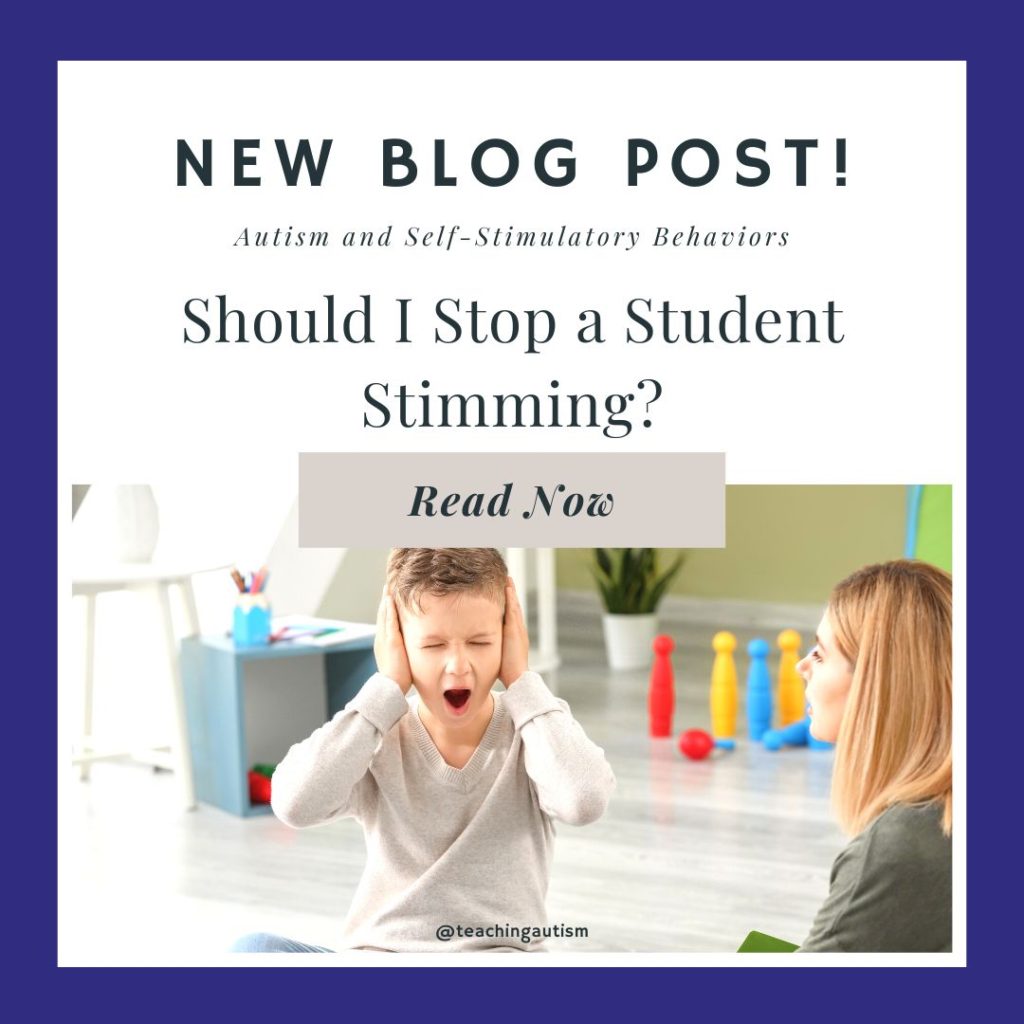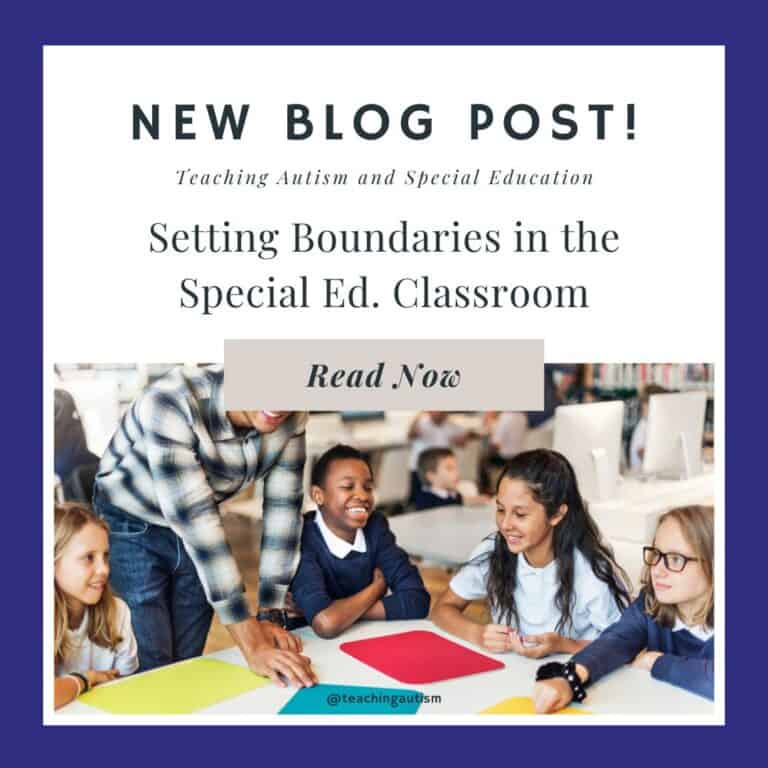Should I Stop My Student Stimming?
Lately I’ve had a lot of educators (and parents too) messaging me asking should I stop my student stimming? I usually get this question from educators who are just unsure how important stimming is, and what to do when it becomes something that is disruptive and/or dangerous. So, after talking to a few autistic adults (one of my favorite things to do!) I decided to put together a blog post about what to do when stimming is becoming either overwhelming.. Or a safety hazard.
Should I Stop My Student Stimming? Why Is It Important?
The short, ideal answer is no. Because your student is most likely stimming because they need to.
Stimming is important because it can help to regulate an individual’s sensory input and to reduce anxiety. It is a natural way for an individual to be able to cope and regulate themselves when things become overwhelming. This can also provide a sense of comfort and routine.
Self-stimulatory behaviors do seem to help individuals to manage their emotions. The ‘stimming’ helps them to focus their attention on what they are doing, which can help them to self-regulate and calm down.
Self-stimulatory behavior is also a great way for individuals to manage anything overwhelming that they are experiencing. This is especially true for processing sensory information. If an individual is feeling overwhelmed, by doing their stim, they focus attention on that. And that can help them to self-regulate.
But, It’s Getting Too Much!?
Ok, we get it. Sometimes, some stims can actually start to frustrate others around them. It may be that their peers have needs different to theirs and some stims may be triggers for other students. And that’s when we start to look at adaptions. You see, we don’t want to remove the stim option for a student; because the reality is, that they need that stim in order to self-regulate. But, we will need to figure out a solution.
Respecting Everyone’s Needs
The important thing to remember is that we do need to respect everyone’s needs. While one student may like to sing, shout and be really loud for their stim.. You may have other students in your classroom who this is a trigger for. And they prefer a quiet environment. So, what now!? Which student do you accommodate?! The best answer is you accommodate both. The realistic answer is.. The best that you can. Because we all know that it can be really hard in the classroom to ensure that we are always accommodating every student at the same time. But, we can try!
Who actually needs to be here right now?!
A question that I will ask myself when I notice that a student’s stims may be impacting others around them.. Or if students are starting to get frustrated with each other. And I think to myself.. who actually needs to be here right now? Can students be split up into separate groups right now so that everyone can do their own thing and self-regulate without others getting upset.
This can look like..
- Some students going outside to sing, dance, be loud. Others staying inside if they want to be quiet.
- You could send some students to the multisensory room to have some quiet, relaxing time.. While you do some big movement brain breaks with students in your classroom.
- Talk to your students and ask them if possible. “What do you need right now?” “Do you think you could come outside to be loud?”
Encourage Students to Respect Their Peers
This is a tough one and ‘respect’ isn’t really the best word to use but it’s hard for many of our students to think about others feelings or the impact certain actions have. So the best way that I try to do this is to have my students respect those around them. Simple things like..
“I need to be loud at the moment because I’m overwhelmed. Can I be loud here?”
“You’re being too loud next to me, could you move back a little bit please?”
This could also be used in reverse too.. We want our students to respect the different stims that our peers do. For example, our students can not expect their peers to accommodate their loud stim, if they refuse to accommodate the stim of a peer who likes to open and close doors.
Make Modifications Where Possible
Sometimes splitting up the class into separate areas just isn’t possible. So another thing you can try is to make modifications. And I don’t mean by stopping the stim or changing it to something completely new. I mean, allowing students to access the stim that they need but making subtle changes that can help accommodate their peers at the same time. Some examples of this are;
- For flicking switches on/off; the lights going on and off can be frustrating for some students. Purchase a plastic switch (most DIY stores do them for real cheap) and have the student flick the switch at their table. This way they get their stim without the lights going on/off and disrupting others.
- If a student likes to be really loud, but other students are sensitive; you can try to offer others quieter areas of the classroom and soundproof headphones.. But they may not always want to use these options. You can offer the ‘loud’ student a separate place to go to be loud. “Come outside with me for 5 minutes and we can be as loud as we want!”
I do think, if possible, it’s great to encourage discussions about everyone’s needs.. But also their likes and dislikes. And what makes people feel comfortable/uncomfortable. You can actually really help with this by providing options to model this. For example..
“I know you want to be really loud right now Alex, but I have a headache. So I’m going to go sit over there. Could you stay here please?”
Stimming is Important
I think the main thing that I want you to take away from this post is that self-stimulatory behaviors are really important for our students. And when they are doing these, it’s because they are self-regulating and calming their anxieties/overwhelm. We don’t want to take away that independence of self-regulation.
Everyone’s needs are important, and we need to consider those at all times.
How Do I Do That?
I won’t lie, as educators we definitely have our work cut out! But I think the best thing to do, is sit down with a pen and paper and make a list of all the stimming behaviors that you currently see in your classroom and who by. Then, make notes of any potential effects they are having on other students.
Now, picture the perfect world. If your classroom was in a perfect world, what would it look like for everyone’s needs to be met? And then start backwards from there. I find it easier to start with what it would look like as a perfect solution. From there, I start to make realistic ways of how I can make that happen.
This could look like.. Having a visual of ‘I want loud, please!” where students hand that to staff when they need to go somewhere to be loud. You can have an area of the classroom that is a dedicated quiet zone. That way, students who get overwhelmed with noise, know that there is a constant safe quiet zone in the classroom that they can go to.
Occupational Therapists
Occupational therapists can also be worth their weight in gold. It can be really overwhelming for us in classrooms trying to figure out everything. Having a chat with an occupational therapist, and inviting them into the classroom can be really beneficial. What they can do, is to help identify what needs the student’s stims are currently meeting. From there, when you have identified what it stimulates, you can also start to come up with other ways to offer your student to stim.
You can find out more about stimming in this blog post here.
If you found this blog post helpful, please consider sharing it with your friends and colleagues on social media.
Thanks,
Nikki
P.S. Have you signed up for a 3 day free trial of our VIP membership yet? If not, click here to do it now and go and get access to a huge range of resources, templates, crafts and more for free.








